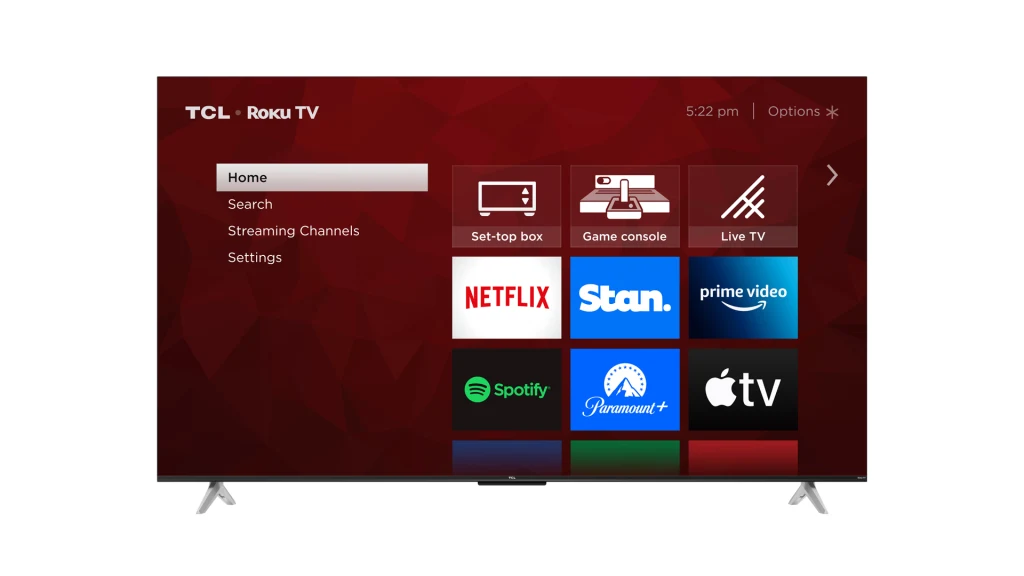Ten years ago, streaming stick maker Roku released its first smart TVs in partnership with Hisense and TCL, two Chinese TV manufacturers that few had heard of in the U.S. at that time. In the years since, Roku has become the domestic smart TV market leader. Its hardware partners have become household names, and sold millions of units to U.S. consumers.
Getting to that point was anything but easy, as I learned during a recent conversation with Roku’s VP of retail strategy Chris Larson and Roku TV VP of business development Tom McFarland. The two actually started this journey together on different sides of the table—McFarland was hired by Roku to get its smart TV program off the ground, and Larson was working for TCL to help the company expand into the States until he eventually joined Roku two years ago.
In our conversation, they recalled countless trips to China, haggling over TV remote designs, and coping with the stress that is today’s TV business.
‘What do you know about TVs?’
When McFarland joined in early 2013, Roku was still a very different company. Four years before its eventual IPO, the startup had just a few hundred employees, and was best known for its streaming pucks and sticks. Convincing TV manufacturers to team up wasn’t easy, McFarland said during our conversation.
“We were talking to everybody in the TV industry,” he recalled. ”We got a lot of skeptical looks, a lot of doubters. They were asking a lot of questions. You’re a streaming company. What do you know about TVs?”
When Roku eventually talked to TCL and Hisense, it quickly became clear that this was a perfect match. Here were two massive Chinese companies in need of a partner that could help them expand to North America. “They had absolutely zero brand recognition here in the U.S.,” McFarland said.
What’s more, Chinese manufacturers were also used to different market dynamics. “We were really good at hardware, but really bad at user experience and software,” Larson said about those early days at TCL. That wasn’t as much of a problem in other markets—after all, it was still early days for smart TVs and streaming in general—but would have been a big issue in the U.S. sooner or later.
“In the United States, the market’s a little different,” Larson explained. “It’s easy to return a TV. In other markets, [like] South America or Southeast Asia, it’s pretty much buyer beware. Once [you] sell a TV, you don’t have to worry about it anymore.”
Whiteboarding, and pressing the right buttons
Signing deals with Hisense and TCL was an important first step. Following through, and actually getting these TVs made and out of the door, was just as challenging.
One problem: As a relatively small startup, Roku simply didn’t have boots on the ground in China. “We were flying a team over there, and we would literally start whiteboarding things with them to [give them the] confidence that we knew what we were doing,” McFarland recalled.
Among the points of contention was the remote control. “Back then, [they] had a remote control [that] had 40, 50, 60 buttons, most of [which] you didn’t know what they did,” said McFarland. “But that was what they were used to.” Roku pushed hard to replace those unwieldy TV remotes with a version of the much simpler remote control it had been shipping with its streaming devices. “We convinced them, [but] it took a lot,” he said.

Building a new kind of streaming TV also required other adjustments for an industry that treated apps and software as an add-on. “You build the TV, and then you just put another board in there with the smarts on it,” said Larson about the common practice at the time. That mindset also led manufacturers to not really worry about upgradeability. “If you shipped the TV with bugs, it was going to have bugs in there forever,” he said. Roku instead downloaded a software update as soon as a device was first connected to the internet.
“Changing the mindset of how product goes to market was really important for manufacturers,” Larson said. As was aligning on timelines. Roku was trying to perfect the user experience of its first-ever TV, while TCL had somewhat different priorities.
“On our side of the table, we wanted to make it cheap and fast, and get it to market,” said Larson. “We’d bust their chops: We need to produce these faster, and your system is slowing us down. It [was] a lot of give and take, a lot of push and pull.”
Getting onto shelves, and fielding customer service calls
One final challenge for Roku and its hardware partners was to win over big-box retailers. “Those national retailers [take on] a lot of risk [with] new brands,” said McFarland. “The last thing they want to do is sell a couple hundred thousand of something that their customers [are] unhappy with.”
Ultimately, retailers had a choice to make, remembered McFarland telling them. “If you want to be in the chair as the world [of] TV changes, you need to get on board. If you want to keep selling Hitachi, Mitsubishi and Panasonic, you’re probably not going to be around that long.”
One of the major retailers placed a first big order for Roku TVs in July of 2014. “It took us about three years to finally complete all national accounts,” recalled McFarland. But the company knew that just getting shelf space wasn’t enough to succeed. “We knew that we only had one chance to be good at this,” he said.
That’s why Roku closely watched consumer ratings and reviews, and also paid close attention to complaints. One of them came from a customer in Monterrey, whose TV wasn’t behaving as expected. “We actually sent one of our lead product managers,” recalled McFarland. “He drove down there, picked up the TV [and] replaced it, because we wanted to figure out what went on.”
Making money, and making your own TVs
Both Larson and McFarland told me that the relationship between Roku and its hardware partners has been great, but there have obviously also been points of contention as Roku’s TV business has grown. One aspect I have heard quite a bit about over the years is Roku’s insistence to own the customer relationship (and the revenue that comes with it) once the TV is sold. TV makers like TCL have been trying to grow their own services revenue with first-party apps, but they’d ultimately like to see more recurring revenues, I’ve been told.
“That’s always a constant tension, where those economics align,” acknowledged Larson, with McFarland adding: “We definitely have had a lot of those difficult conversations.” The duo didn’t go into details about Roku’s commercial relationships with me, but they did defend Roku’s stance in principle by pointing out that Roku has been spending close to $1 billion on R&D each year over the past couple years. “There’s just massive investment that we’ve had to put into this thing for years,” he said.
The latest twist in the relationship between Roku and its partners came in 2023, when Roku announced that it would be making its own TVs in addition to those made by partners like TCL. Going it alone came with a lot of added monetary risk for Roku, acknowledged McFarland. “It’s not an easy financial decision.” But it also allowed the company to innovate without having to convince its partners of every single change.
“We had desires to launch some features that added cost to the hardware,” McFarland said. “With a licensed program like this, it’s very difficult to convince them to take on that extra risk. Something as simple as a remote control going from IR to Bluetooth, or with added headphone functionality: That really added a lot of cost,” he said. “They just couldn’t get their mind around how that’s going to help them sell more TVs.”
By proving these things out on its own TVs first, Roku now has better chances to convince its partners as well, the duo told me, while also acknowledging that Roku making its own hardware can add some tension to conversations with partners. “It is challenging,” McFarland said.
Making and selling TVs can be a very stressful business
TVs are one of the few (if not the only) consumer electronics products with a consistently declining price tag. Consider this: When Apple released the original iPhone in 2007, it was priced at $599. The new iPhone 16 starts at $799. The average price of a TV sold in the U.S. declined by more than 90% over the same time period, according to the Bureau of Labor Statistics.
It’s a dynamic that Larson, who worked for Toshiba before joining TCL and ultimately Roku, has seen play out firsthand.“The first 15 years I was in this business, it was a much easier business,” he said. “There was a lot of profit in it. It was controlled by just a few suppliers and brands. The last 15 have been a little more challenging.”
At the same time, there has been an upside to this free-fall. Big, high-end TVs used to be a luxury good, with Larson calling it a “Hi-Fi world.” Now, people can buy a 65-inch 4K HDR TV for $300. “It’s a stressful business,” Larson acknowledged. “But it’s a fun business. We’re not saving babies. We’re not curing cancer. But we’re bringing delight into people’s homes.”
“The last 10 years have been probably the most fun you can imagine,” Larson added.
This story originally appeared on Janko’s newsletter Lowpass. Subscribe here.
Ak chcete pridať komentár, prihláste sa
Ostatné príspevky v tejto skupine

The trope of the starving, broke artist has long maintained a place in the public imagination, even as it has morphed into idealized notions of “‘hustle” or “grindset.” “It’s cool to romanticize [

When Apple first introduced MagSafe for the iPhone in 2020, I did not fully appreciate it.
iPhones had supported wireless charging for a few years at that point—and Android phones starte

Even if you’re a regular Alexa user, there’s a good chance you haven’t discovered some of its most efficient features.
Actually, strike that: There’s a good chance you’

The Fast Company Impact Council is a private membership community of influential leaders, experts, executives, and entrepreneurs who share their insights with our audience. Members pay annual

Cryptocurrency exchange Bybit said last week hackers had stolen digital tokens worth around $1.5 billion, in what researchers called the biggest crypto heist of all time.
Bybit CEO Ben Z


Anthropic released on Monday its Claude 3.7 Sonnet model, which it says returns results faster and can show the user the “chain of thought” it follows to reach an answer. This latest model also po
